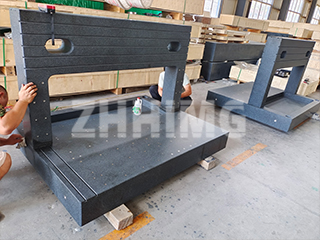When it comes to precision measurement, granite surface plates are considered the gold standard. Their natural stability, exceptional flatness, and resistance to wear make them indispensable in metrology labs, quality inspection rooms, and high-end manufacturing environments. However, while most users focus on surface accuracy and tolerance, there is another crucial factor that directly influences the performance and longevity of a granite plate — its thickness. Understanding how thickness is determined and how it relates to load capacity and stability is key to selecting the right platform for your equipment and ensuring long-term measurement accuracy.
The thickness of a granite surface plate is far more than just a dimensional specification. It is the foundation of the plate’s structural integrity. The thicker the granite, the greater its ability to support heavy equipment without bending or deflecting. This directly affects measurement reliability because even minimal deflection — sometimes measured in microns — can lead to inaccuracies in inspection or calibration. On the other hand, a plate that is excessively thick might be unnecessarily heavy, expensive, and difficult to install. The ideal solution lies in balancing thickness with the demands of the application.
One of the primary considerations when determining thickness is the weight of the equipment that will be placed on the plate. For light-duty applications — such as microscopes, gauges, or small measuring tools — a thinner plate may be sufficient, as the load applied is minimal. But as the weight increases, so must the thickness. Machines like coordinate measuring machines (CMMs), optical measuring systems, or heavy assembly fixtures exert significant force on the surface, and a plate with insufficient thickness could gradually deform under the load. Over time, this deformation leads to a loss of flatness, compromising the very purpose of using a precision surface plate.
Thickness also plays a vital role in the plate’s ability to resist environmental influences. Granite naturally expands and contracts very little with temperature changes, but thicker plates are even more resistant to thermal fluctuations. They possess a larger thermal mass, meaning they react more slowly to temperature variations, which helps maintain dimensional stability even when the surrounding environment is less than ideal. This feature is particularly valuable in workshops or manufacturing facilities where temperature control is difficult.
Another aspect influenced by thickness is the long-term service life of the granite plate. A plate with the correct thickness for its application can remain stable and accurate for decades. In contrast, one that is too thin for the load it supports may initially meet flatness requirements but gradually lose its precision as the years go by. This kind of slow deformation is often irreversible and may require costly resurfacing or complete replacement.
Industry standards such as DIN, JIS, and ASME provide recommended thicknesses for different plate sizes and accuracy grades, but these should be considered guidelines rather than strict rules. Every application is unique, and factors such as the total load, how the load is distributed, the presence of dynamic forces, and the type of support structure used beneath the plate can all influence the ideal thickness. It’s always advisable to consult with the manufacturer when specifying a granite plate, especially for non-standard or heavy-duty applications.
In practical terms, the relationship between size, thickness, and performance is straightforward. Larger plates need greater thickness to maintain rigidity over their surface area, and higher accuracy grades typically demand thicker plates to minimize deflection. For example, a 1000 mm surface plate used for general inspection may be 150 mm thick, whereas a 2000 mm plate supporting a heavy measuring machine might require 300 mm or more. Manufacturers like ZHHIMG provide detailed specifications and load capacity charts to guide customers toward the most appropriate design for their needs.
Maintenance also plays a role in preserving the performance of a granite surface plate, regardless of its thickness. Keeping the surface clean and free from dust, avoiding sudden impacts, and ensuring the plate is not overloaded are essential practices. Regular calibration checks are also recommended to verify that the flatness remains within acceptable limits. With proper care, a well-chosen granite plate can deliver stable and reliable measurements for decades.
In the end, thickness is more than just a physical measurement — it is a critical engineering parameter that underpins the functionality, durability, and precision of a granite surface plate. By carefully considering the weight of your equipment, the environment in which the plate will be used, and the expected service life, you can select a platform that will support your precision work for many years. As manufacturing tolerances become increasingly tight and measurement accuracy more critical than ever, paying attention to details like plate thickness is not just a technical necessity — it’s a competitive advantage.
Post time: Sep-25-2025

